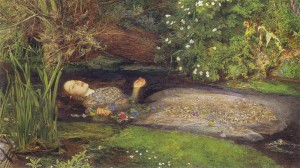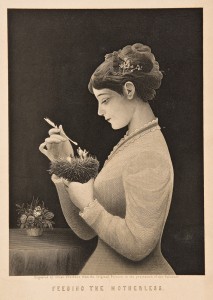“Thursday, 25th July. I had the oddest dream last night that I ever dreamt; even the remembrance of it is very extraordinary. There was a very nice pretty young lady, who I (a girl) was going to be married to! (the very idea!). I loved her and even now love her very much. It was quite a settled thing and we were to be married very soon. All of a sudden I thought of Teddy and asked Mama several times if I might be let off and after a little time I woke. I remember it all perfectly. A very foggy morning but Henry said it would be fine, but I do not think it has. It feels very thundery. This afternoon we began making our Harmonicons. I did not succeed very well, and got rather out of patience. Sent one piece to the Carpenter to plane, as that is the only thing we cannot master. Went out for about half an hour. It rained hard, this evening, so we did not go out.” – Emily Pepys
During the Victorian era, diary entries helped provide insight to the coded and hidden thoughts and lives of Victorian women. This is why I chose a series of diary entries from the ten-year-old Emily Pepys written over July 1844 to January 1845 as my primary text. The entries range from day to day interactions with other young children and adults, playing outside, and other activities a ten-year-old Victorian girl would take part in. Ideas circulating marriage, social responsibilities, and proper etiquette also litter the diary. One entry in particular struck me as it addressed relations among women. Throughout our course of study and reading The Women in White I have been fascinated with these types of relations and the way in which female sexual politics are expected to play out in Victorian society. And in this entry, Emily Pepys rather unknowingly steps outside of heteronormative modes of being, securing her entry’s rightful place in this archive.
This entry from July 25th, 1844 is loaded with hidden meanings. Emily writes that she had “the oddest dream last night that [she] ever had dreamt” but it was truly extraordinary. The word “odd” in particular strikes me immediately as it is linked to the rudimentary definition of queer as being strange or odd. But also this attention to something being extraordinary allows this queerness to exist in an acceptable way. Dreams are also a concept that we’ve talked about a lot in this course as a sort of space to play out non-normative or sexual ways of being, and Emily does just this. She tells us the rather sensational news of her dream, “There was a very nice pretty young lady, who I (a girl) was going to be married to! (the very idea!)” (Avery, 32). The use of Emily’s form is key here. She uses italics and parentheticals to exclaim just how exciting but also different this dream was. The young “lady” in question seems to be an ideal wedding partner; she’s nice, pretty, young and Emily would “be married to” her! This excerpt followed along with “(the very idea)!” shows us how this dream differs from normative ways of being in her society. This idea of her marrying another young lady is rather crazy to Emily because of the society she lives in, but she welcomes it whole-heatedly. She claims that she “Loved her and even now love her very much,” and it was “quite a settled thing” (32-33). Emily’s refreshing but maybe also childish acceptance of this dream is what queers her from her Victorian counterparts. But in some fashion, I hope she does see the value in woman to woman relations.
Despite this uplifting take, Emily takes a step back when she “All of a sudden” thinks of Teddy, the boy she has a crush on (32). Now this could be explained in two ways. It could be that just the mere mention of marriage makes her want to revert back to heteronormative ways of being, as evident in this quote in a prior entry: “I think in that way I shall be quite fit to be Teddy’s wife,” (28). Or simply she’s a child with a short attention span that has a crush on a boy. I think both might be true. But the above quote suggests that there’s a certain way that she has to act in order to become his wife, while with this other young lady it is already “quite a settled thing”. Emily then goes about her day, claiming that the morning is very “thundery” or as our class would like to describe, filled with vibrations. She then makes Harmonicons with friends, but finds herself distracted and out of patience, and the entry ends rather abruptly. What makes this entry queer is that there are two relations at play: one that is very concrete and definite yet existing in this dream world, and one that hasn’t quite figured itself out yet. It’s queer because the woman to woman relationship is concrete while her relationship with Teddy is not. And although she may be engaged to this woman in a dream world, she seems way more sure of it, than with the heteronormative one. Although Emily might be young, this sort of naive same-sex desire is rather refreshing during the Victorian Era. In a time where heteronormative relations are required, this young girl’s dream falls excitingly out of place.
Archive Link: http://vqa.dickinson.edu/diary/journal-emily-pepys
Full text/photos from:
Avery, Gillian, ed. The Journal of Emily Pepys. England: Prospect Books, 1984.

